3ll3d00d
Senior Member
- Joined
- Aug 31, 2019
- Messages
- 308
- Likes
- 245
You can't. The feature added in mc31 is the ability to bitstream Atmos audio files.Do you have any info whether it will be possible to filter and play Atmos with Jriver 31?
You can't. The feature added in mc31 is the ability to bitstream Atmos audio files.Do you have any info whether it will be possible to filter and play Atmos with Jriver 31?
Do you have any info whether it will be possible to filter and play Atmos with Jriver 31?



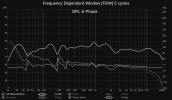

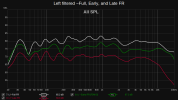

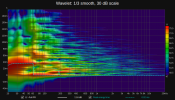

Butthere's not much reason to upgrade at this time
I used to do that and even before REW introduced Inverse phase trace artihmetic. In fact one of my earlier videos is on that where I was using XL hacks to invert fwd EP. But my right speaker doesn't smooth enough to avoid ringing even at 2cycles fdw and at that fdw, it has very minimal effect on the coherence with the left speaker. Dual allpass filters acting fwd and backwards in time on the same frequency are fixing many of the EP problems I never thought were possible to fix. IIR filters help a little, yes but by definition they're min phase so they only effect EP a min amount(FDW 5 cycles) excess phase inversion
That's very true. I need room treatment but it's a science I am very ignorant of and a bit too late to jump in. I have seen room measurements when it's done wrong and it scared me.The full and early frequency curves are flattish enough considering its a non-acoustically treated in-room measurement
But Atmos DSP capability if true, could be a game changer, a lot of people are desperately looking for it since years.

Ironically, I listen currently on portable speakers e.g. phone, Alexa devices, cans/IEMs despite having three proper listening MCH and stereo setups at home, and a coax speaker system in the bedroom.
There's a way at the moment and it's brilliant work but its quite cumbersome. A guy has written code (it's open source and free) which maps Atmos channels to floor channels you don't have and then you eq these channels as you wish (with all the FIR power of your PC through JRiver or EQ APO for instance) and it plays them back with its convolver again in Atmos format. The downside is you have to do the first conversion beforehand to play them right later. Also because PCs are limited to 8 channels (7.1), 5.1.2 Atmos is your only option. But it's still something. An Atmos mixing engineer admitted the base layer is usually 5.1.2 and 7.1.2 anyway and the rest is improvized by the algorithm.Ironically, I listen currently on portable speakers e.g. phone, Alexa devices, cans/IEMs despite having three proper listening MCH and stereo setups at home, and a coax speaker system in the bedroom.
I also am not keen on getting a "bulky" separate Atmos capable AV receiver/processor. If they can fit it into a miniDSP sized box, then count me in!
Your processor and pre-amp is your PC, add a couple of Topping units (I mean if all the vibe going on here about them is true...) and some high sensitivity ceiling speakers and you will be golden (and you will have many more channels to design the "perfect" filters forIf they can fit it into a miniDSP sized box, then count me in!
You mean you both listen to each otherI listen currently on portable speakers e.g. phone, Alexa devices
I'm testing the blip at 68Hz, because the filtered IR tab in REW has 63Hz preset to make testing quick.most notches are "maximum phase"....the more you boost them, the more they ring.
here is L0 with a minimum phase total inversion:

with minimum phase filters they are best left alone.
they can be corrected with FIR, but that is very complicated these notches are very position specific.
the only real way to deal with excess phase is to treat the room.
You can see if I made an custom IR with that delay, the cancellation direct wave would cancel the original "2nd hump", but then the cancellation wave would have it's own 2nd hump. This could be good or bad, and it seems from a few trials that it's often bad because there's a high chance of phase shift over that long of a time period (look at the dramatic phase shift at 100ms for example). If it were good (destructive), then it would improve the decay, but if it's bad (constructive), then it will just make more noise at the time, in fact making the decay worse. Then I wonder if I need to "cascade" cancellation tones, to cancel the OG cancels 2nd hump? When would it end?!

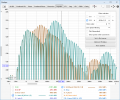


Minimum phase filters have much stronger post ringing but if you also need some pre-ringing you can try using linear phase filters, min phase filters have none. You can make linear ph eq filters easily in rePhase.optimal being more ringing of the echo at the time when I want it too
I haven't tried rePhase. Are there any other programs that can make different filters? But then more importantly, can these filters be put in to REW as an IR and used for testing? Because a while ago I tried to re-import a VBA IR that I had exported from REW, and the import worked, but when I convolved it, none of the phase or spectrogram data got calculated, only the frequency. It was strange. Not sure if it was a bug.Minimum phase filters have much stronger post ringing but if you also need some pre-ringing you can try using linear phase filters, min phase filters have none. You can make linear ph eq filters easily in rePhase.
You wouldn't need more than rePhase really but there are a few paid software around. Most tools come as VST plugins for studio engineers. They talk a lot about Kirchoff EQ for example. But that's a different World.I haven't tried rePhase. Are there any other programs that can make different filters? But then more importantly, can these filters be put in to REW as an IR and used for testing? Because a while ago I tried to re-import a VBA IR that I had exported from REW, and the import worked, but when I convolved it, none of the phase or spectrogram data got calculated, only the frequency. It was strange. Not sure if it was a bug.


On the formula of the RT60, etc, etc, I recommend the latest advances of Mr. Ron Sauro.Unfortunately, it's not that simple. There are 6 reflections (floor, ceiling, left side wall, right side wall, front wall, rear wall) from two speakers and their first, second, third bounces are all in action to add up or cancel out each other in a chaotic fashion. Furthermore, depending on the frequency affected by the time delay of the bounced wave, the signal origination source will switch i.e. first floor reflection might cause a dip at 210Hz which will be from woofer or at 280Hz which will be from the midrange driver which is located at a different height to floor than the woofer. And this is all if you have flat surfaces with identical reflective properties all around the room which is never the case.
As per your questions:
1. VBA will remove "half" of the first and the largest dip inevitable in every room which is not possible with EQ and that's an audible improvement. It will boost and extend bass below the first peak although in your case that may not be audible since your system can already produce bass down to the limits of human hearing.
2. Yes because EQ only decreases the volume of the problem frequency at the source, VBA doesn't intervene at the source but wipes out its reflection permanently.
3. That's only the long wall axial mode formula and is good for double bass arrays as they have no choice but place a second sub on the opposite wall. The formula involving the sum of all three room dimensions gives a good approximation for the room resonant frequency:
There're more precise and a lot more complex methods. "Sabine formula" to calculate from the volume of the room is one of them if you're interested:
f = c / (2 * (L + W + H))
RT60 calculator Wallace C. Sabine calculation reverb time reverberation time Sabin Sanine's formula online sound pressure sound level - sengpielaudio Sengpiel Berlin
RT60 calculation Wallace C. Sabine reverb time reverberation Sabin Sanine's formula online sound pressure sound level - Eberhard Sengpiel sengpielaudiowww.sengpielaudio.com
There's a way at the moment and it's brilliant work but its quite cumbersome. A guy has written code (it's open source and free) which maps Atmos channels to floor channels you don't have and then you eq these channels as you wish (with all the FIR power of your PC through JRiver or EQ APO for instance) and it plays them back with its convolver again in Atmos format. The downside is you have to do the first conversion beforehand to play them right later. Also because PCs are limited to 8 channels (7.1), 5.1.2 Atmos is your only option. But it's still something. An Atmos mixing engineer admitted the base layer is usually 5.1.2 and 7.1.2 anyway and the rest is improvized by the algorithm.
Ripping EAC-3 Atmos from Blurays is quite easy with free tools like tsMuxer and Eac3To and the Atmos quality in Blurays are way above the usual streamers.
Cavern Documentation
Free room correction suite and Dolby Atmos decoder for PC. Improve the sound quality of your home theater and enhance your listening experience.cavern.sbence.hu
On the formula of the RT60, etc, etc, I recommend the latest advances of Mr. Ron Sauro.
Apparently at the end of this year the official papers will be presented.
written with translator
Greetings
I just did, thanks!
The idea is to cancel reflections. If you have speakers with a smooth on axis bass response, then the only reason you are not hearing a smooth response in room is because of the reflections and the way they combine at the listening position (and decay is just reflections that are still reflecting). If you could perfectly cancel them at the LP with no side effects, then that would imply reduced decay, and it would make the direct wave the dominant portion of the IR, which implies correct phase and better group delay. Room treatment does this by lowering the SPL of the returning waves, whereas VBA wants to lower the SPL by cancellation at the LP.I've read the entirety of this thread and I'm really confused about what the practical application is?
It seems you'd get significantly better results with room treatments,

"Multi sub" doesn't fix the decay side of things at all. Also I'm sceptical of its ability to fix an issue related to a room length mode, which seem to be the worst problems. The speaker/subs position doesn't affect the room mode because eventually all direct waves will reflect off the back wall and "become the mode". So the only benefit I can see (to the room length mode) for multi-sub (that is in phase at the LP) is that it possibly has a slightly different timed direct wave (if you set it up that way), and different reflection times relative to the LP off other walls. But the direct wave is kind of irrelevant, because that arrives within 20ms even in large rooms (20ms = ~6.9m), whereas the "peak energy time" is often much later, like in the 50-100ms range in the attached example. And reflections off other surfaces won't have gain like a room mode can (but possibly many will arrive at once). Possibly you could arrange a 2nd sub somewhere behind the LP so that its direct wave arrives in phase and time with the 1st subs direct wave, but then their physical offset could mean that their reflections were out of phase (again due to a difference of "propogation vectors").additional subwoofer(s)
This was a good video by the way. I watched a few others on the channel with Ron Sauro in them too. In one of them he says something along the lines of "effective narrowband bass absorption is hard, and that the people that know how aren't giving up their secrets because they have patents and the market cornered". So in regards to my other comment about DIY bass absorption, maybe it's not so feasible.On the formula of the RT60, etc, etc, I recommend the latest advances of Mr. Ron Sauro.
Apparently at the end of this year the official papers will be presented.
written with translator
Greetings
Sorry, I wasn't trying to be a knob. Though the above part I disagree with."Multi sub" doesn't fix the decay side of things at all. Also I'm sceptical of its ability to fix an issue related to a room length mode, which seem to be the worst problems. The speaker/subs position doesn't affect the room mode because eventually all direct waves will reflect off the back wall and "become the mode". So the only benefit I can see (to the room length mode) for multi-sub (that is in phase at the LP) is that it possibly has a slightly different timed direct wave (if you set it up that way), and different reflection times relative to the LP off other walls. But the direct wave is kind of irrelevant, because that arrives within 20ms even in large rooms (20ms = ~6.9m), whereas the "peak energy time" is often much later, like in the 50-100ms range in the attached example. And reflections off other surfaces won't have gain like a room mode can (but possibly many will arrive at once). Possibly you could arrange a 2nd sub somewhere behind the LP so that its direct wave arrives in phase and time with the 1st subs direct wave, but then their physical offset could mean that their reflections were out of phase (again due to a difference of "propogation vectors").
Anyway, there are other minor benefits to the VBA method I have showed. So even if I can't reach the holy grail of cancelling all reflections, I think I will still use an "echo wave" at certain frequencies because it gives benefits that EQ filter does not (eg in the case of a long tone, it can give strong initial wave with in-room SPL "stable" secondary waves). It can also give some decay reduction.
Also it's been quite fun learning new things in this thread. I have a much better understanding of many things now. So whilst this isn't a ready to go solution, you too might like to do some experimenting? I've listed many ideas that I've not yet been able to test. However, I think I've seen your other posts where you say your room is well treated. Perhaps this means there is limited scope for VBA style improvements in your room. It would help me if you could upload some measurements so I can see for myself. L and R and sub would be good (if you have sub or subs). If you do upload, it would also help if you provide a layout of your room with dimensions (eg a screenshot of REW Room Sim).
Can you provide a screenshot of REW Room Sim that reflects the above room and sub positions, including any adjustments to phase/delay/gain?Sorry, I wasn't trying to be a knob. Though the above part I disagree with.
Issue at 135hz is my length mode. It's a huge null given my listening position.
View attachment 306412View attachment 306414
Added a second sub:
View attachment 306413
Not only does it fix the issue at 135hz, it straightens everything else out.
FR comparison of problematic speaker (right) with and without second sub.
Green is 2 subs, purple 1.
View attachment 306415
Decay times with 2 subs:
View attachment 306416
Decay time with 1:
View attachment 306418
Minor difference, but it's still there all the same.
The issue is most people who go with multiple subs don't take the time to properly integrate them into the system. And keep in mind, doing either RTA sweeps or single point sweeps in nearly a 3'x3' area all yield very similar results. This to me was the biggest thing with a second sub was being able to move my head and not have any issues. Listening to music in a vise doesn't sound very appealing.
Again, not trying to be a knob, most of what your doing is over my head to begin with, but I would refute that a second sub has little to no benefit past the frequency response.
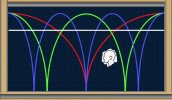

Decay time with 1:

I'm no expert either. Everything I know (or that I think I know) has been learned in the course of this thread. Multi sub has obviously fixed your SPL at the moment of "peak energy". Your room sim screenshot will really help me understand why the issue was there in the first place, and why multi sub helped it the way it did.most of what your doing is over my head to begin with, but I would refute that a second sub has little to no benefit past the frequency response.
